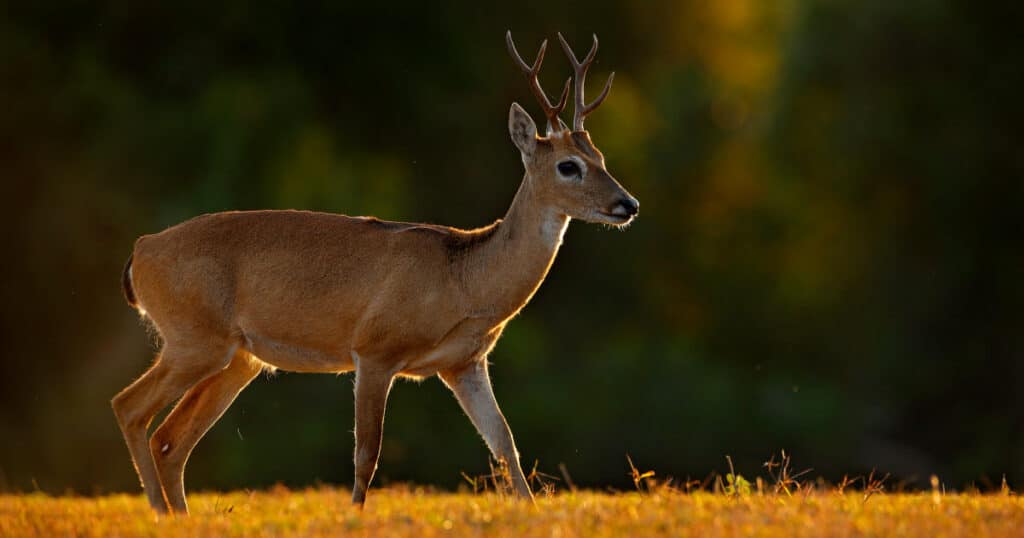The Pampas Deer (Ozotoceros bezoarticus) inhabits the wet and grassy lowlands of its range in South America. This species is endangered due to a loss of its preferred habitat and over-hunting, and is the beneficiary of conservation efforts designed to protect this deer as a vital part of its native ecology.
On this page we’ll share facts and information about Pampas Deer including its size, appearance, habitat, unique behavior, mating habits and reproductive cycle.
What Size are Pampas Deer?
Table of Contents
Toggle- Head & Body Length – 110 to 130 cm
- Shoulder Height – 70 to 75 cm
- Tail Length – 10 to 15 cm
- Weight – 30 to 40 kg.
What do Pampas Deer Look Like?
The Pampas Deer is similar in proportions as the Roe Deer of Europe. It has a long thin body and is fairly high-legged.
The coat of this deer is a yellowish brown color, and the under-coat is particularly thick and dense. The under parts are whitish in color. On the back there is a small hair whorl which is distinct and notable.
The Pampas’ tail has a white underside.
Antlers
The male Pampas Deer have antlers which are relatively simple and have only three tines; a single forwards pointing tine and two backwards-pointing tines.
The antlers are lost in the autumn and grow again during the following spring.
Differences Between Pampas Deer and Marsh Deer
Although the Pampas Deer has a similar distribution to the Marsh Deer and is superficially similar in appearance, it differs in having less complex antlers, and by being smaller and darker in color. The ears are also smaller than those of the Marsh Deer.
Habitat & Range
Now we’ll share a closer look at the habitat and distribution of Pampas Deer around the world:
Preferred Habitat of Ozotoceros bezoarticus
This species is found on the grassland plains of South America that are known as the Pampas.
Ozotoceros bezoarticus prefers dry grassland areas. It can be found along the south east of South America, and inhabits Brazil, Argentina, Uruguay, and Paraguay.
Where Can You Find Pampas Deer?
Originally the Pampas Deer was found throughout the whole Pampas region of South America, and this species occurred in large numbers.
Today, however, its numbers have fallen steadily since this area began to be used for cattle ranching.
The Pampas grasslands of South America were ideal for raising cattle, and the native deer of this area were forced out to make way for large cattle herds.
As their native habitat was taken for farmland, the Pampas Deer was forced onto the edges of cultivation.
Couple loss of habitat with the spread of disease from domestic animals, and over-hunting and the negative impact on this species of deer is easy to understand.
The outlook for this species appears bleak, unless conservation measures are taken to prevent numbers from falling further. They may have a future in protected areas in the region.
Today, the exact status of the species is unclear, but it is certain that it has disappeared from much of its former range.
Unique Habits & Behavior
The Pampas Deer is active at night, resting during daylight hours in long grass where it can easily remain hidden.
This deer feeds on various species of grasses.
When they are alarmed Ozotoceros bezoarticus flee with high leaps, and lift their tail high, exposing the white underside.
Although the Pampas Deer is a fast runner, it can only run for short periods of time before becoming fatigued. Throughout the winter they live alone, or in pairs. But with the return of spring they gather into larger groups, forming herds of about 10 to 20 animals.
Mating & Reproduction
The rut occurs at the end of spring, although the timing is somewhat flexible.
During the rutting season the glands between the hooves of the deer begin to smell strongly of garlic. When Charles Darwin was visiting the area aboard The Beagle, he noted the strong smell the deer produced which could be smelled at a distance of up to 3 kilometres!
During the rut, Pampas Deer live in pairs, and after a gestation period, a single calf is born.
The male stays with the mother and calf while the calf is young — behavior which is quite unusual among deer.
The calves have 4 pale stripes along their body from birth, although these fade with age. The calves are weaned at about 7 weeks of age, and the young Ozotoceros bezoarticus reach sexual maturity at around a year of age.


